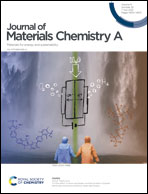A novel sodium-ion supercabattery based on vacancy defective Ni–Co–Mn ternary perovskite fluoride electrode materials†
Abstract
In this work, we have proposed a new concept of sodium-ion supercabatteries (i.e., sodium-ion capacitors/batteries, SICBs) based on a novel vacancy defective Ni–Co–Mn ternary perovskite fluoride K0.71Ni0.12Co0.41Mn0.47F2.77/reduced graphene oxide (i.e., KMF(244)/rGO) anode and a capacitor/battery (activated carbon/Na3V2(PO4)2O2F, i.e., AC/NVPOF) hybrid cathode, which reduce the gap between sodium-ion capacitors (SICs) and sodium-ion batteries (SIBs). The KMF(244)/rGO anode, with the synergistic effect of Ni, Co, and Mn redox species and K/F vacancy defects, presents remarkable specific capacity, rate and cycle performance, showing pseudocapacitive-dominated conversion/intercalation dual mechanisms. Interestingly, the KMF(244)/rGO//AC/NVPOF SICBs exhibit superior performance to KMF(244)/rGO//AC SICs and KMF(244)/rGO//NVPOF SIBs, which largely benefits from the synergistic energy storage superiority of SICs and SIBs showing pseudocapacitive, capacitive, and faradaic behavior in electrochemical processes. To sum up, our study presents a novel concept of sodium-ion supercabatteries realized by using the vacancy defective Ni–Co–Mn ternary perovskite fluoride anode with pseudocapacitive-dominated conversion/intercalation dual mechanisms and an AC/NVPOF capacitor/battery hybrid cathode, providing new insight into developing advanced energy storage devices and in-depth understanding of the charge storage mechanisms.



 Please wait while we load your content...
Please wait while we load your content...